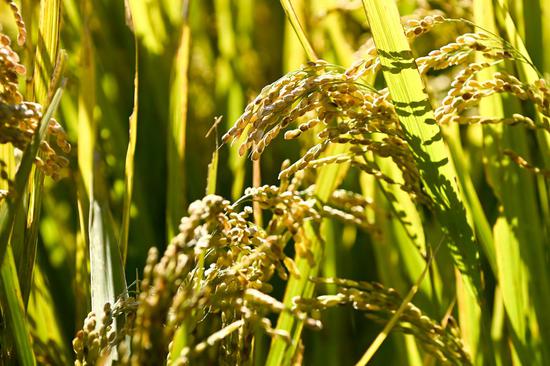
Photo taken on Oct. 11, 2021 shows ripe rice in Guangdong Village of Yanbian Korean Autonomous Prefecture, northeast China's Jilin Province. Jilin recorded a bumper grain harvest, with the total grain output reaching 40.39 million tonnes this year, up more than 2.36 million tonnes year on year, according to data released by the National Bureau of Statistics. (Xinhua/Yan Linyun)
An international group of scientists has made a global assessment of rice-cropping systems in search of opportunities to improve rice production.
Rice is the main staple food for more than half of the global population. Although the demand for rice is expected to grow, its production is challenged by factors like climate change, energy shortages and resource degradation.
Researchers from China, the United States, Brazil, Indonesia, India, Uruguay and several global research institutes assessed rice yields and efficiency in using water, fertilizer, pesticides and labor across 32 rice-cropping systems that account for half of the rice harvested globally.
According to the results published in Nature Communications, there is still substantial room for increasing rice production and reducing the negative environmental impact.
Yield potential is defined as the yield of a cultivar when grown in environments to which it is adapted, with no limits on nutrients or water, and with pests, diseases, weeds and other stresses effectively controlled.
The assessment shows the global average rice yield represents 57 percent of the yield potential, with a wide range of gaps across rice systems.
Irrigated rice systems in Egypt, northern China, Australia and California in the United States have reached over 75 percent of the yield potential. About two-thirds of the total rice-producing area among the 32 evaluated cropping systems has yields less than 75 percent of the yield potential. Average yields are low for rain-fed lowland rice in Sub-Saharan Africa and upland rice in northern Brazil, representing 20 to 40 percent of the yield potential.
The researchers say that increasing the average yield to a level equal to 75 percent of the yield potential in 19 cropping systems would increase global annual rice production by 32 percent, sufficient to meet the projected global rice demand by 2030.
Nitrogen balance is a strong indicator of inefficient fertilizer use and potential reactive nitrogen losses into the environment, which suggests a high risk of degrading soil quality.
The results show that reducing the current large nitrogen balance observed in eight cropping systems is equivalent to a 95 percent reduction across the 32 cropping systems.
The authors say the study provides strategic insight into the yield gap and resource-use efficiency that is essential for prioritizing national and global agricultural research and development investments, to ensure adequate rice supply while minimizing the negative environmental impact in the coming decades.

- China’s new rice varieties up 40% yields
- Chinese scientists find new way for robust DNA data storage: Nature
- Chinese scientists discover new lunar mineral
- Space station rice tests show promise
- Three scientists win China’s 2022 Future Science Prize
- Scientists design two-in-one antibodies against COVID-19 variants
Popular Videos
Hot comments
- First apes at U.S. zoo receive COVID-19 vaccine made for animals, zoo official says
- China Life: Chinese women shine with She Power
- Foreign firms approved to offer VPN services in capital
- Homemade curling videos trending in China
- 86-year-old grandma in Hebei spends most her life on traditional cheongsam
- Winners of 2022 Inaugural WLA Prize announced
- Lantern Festival: A romantic celebration in China
- Two Chinese COVID-19 vaccine firms to supply vaccines to COVAX
- Media center for 20th CPC national congress to open on Oct. 12
- Six suspects arrested in HK for role in SE Asia job scam
Top Reviews
- Young artists recreate beauty of traditional Hanfu costume
- China releases photos of tallest tree
- English version of ‘Understanding Xi Jinping’s Educational Philosophy’ published
- China crowned in men’s team for 10th straight time at table tennis worlds
- China publishes Atlas of Wildlife in SW China
- Guangxi’s 10 Years: A Visit to China’s Qinzhou Port
- Congress delegate helped lift village out of poverty
- Expo highlights joint efforts in NEV development
- Racism stain of shame on ‘world democratic paradise’
- U.S. may face new COVID wave this upcoming winter: report







